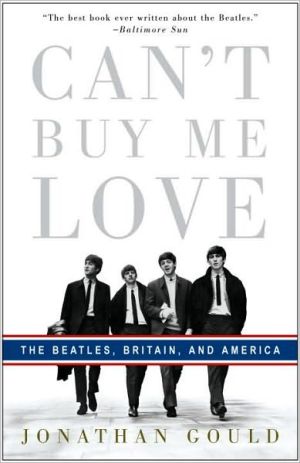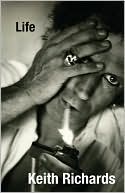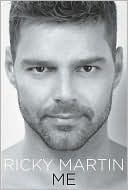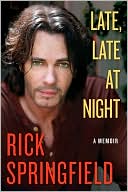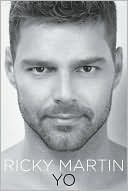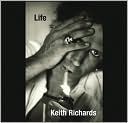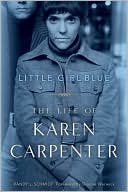Can't Buy Me Love: The Beatles, Britain, and America
Nearly twenty years in the making, Can’t Buy Me Love is a masterful work of group biography, cultural history, and musical criticism. That the Beatles were an unprecedented phenomenon is a given. In Can’t Buy Me Love, Jonathan Gould seeks to explain why, placing the Fab Four in the broad and tumultuous panorama of their time and place, rooting their story in the social context that girded both their rise and their demise.\ Beginning with their adolescence in Liverpool, Gould describes the...
Search in google:
Nearly twenty years in the making, Can’t Buy Me Love is a masterful work of group biography, cultural history, and musical criticism. That the Beatles were an unprecedented phenomenon is a given. In Can’t Buy Me Love, Jonathan Gould seeks to explain why, placing the Fab Four in the broad and tumultuous panorama of their time and place, rooting their story in the social context that girded both their rise and their demise. Beginning with their adolescence in Liverpool, Gould describes the seminal influences––from Elvis Presley and Chuck Berry to The Goon Show and Alice’s Adventures in Wonderland––that shaped the Beatles both as individuals and as a group. In addition to chronicling their growth as singers, songwriters, and instrumentalists, he highlights the advances in recording technology that made their sound both possible and unique, as well as the developments in television and radio that lent an explosive force to their popular success. With a musician’s ear, Gould sensitively evokes the timeless appeal of the Lennon-McCartney collaboration and their emergence as one of the most creative and significant songwriting teams in history. And he sheds new light on the significance of Sgt. Pepper’s Lonely Hearts Club Band as rock’s first concept album, down to its memorable cover art.Behind the scenes Gould explores the pivotal roles played by manager Brian Epstein and producer George Martin, credits the influence on the Beatles’ music of contemporaries like Bob Dylan, Brian Wilson, and Ravi Shankar, and traces the gradual escalation of the fractious internal rivalries that led to the group’s breakup after their final masterpiece, Abbey Road. Most significantly, by chronicling their revolutionary impact on popular culture during the 1960s, Can’t Buy Me Love illuminates the Beatles as a charismatic phenomenon of international proportions, whose anarchic energy and unexpected import was derived from the historic shifts in fortune that transformed the relationship between Britain and America in the decades after World War II. From the Beats in America and the Angry Young Men in England to the shadow of the Profumo Affair and JFK’s assassination, Gould captures the pulse of a time that made the Beatles possible—and even necessary. As seen through the prism of the Beatles and their music, an entire generation’s experience comes astonishingly to life. Beautifully written, consistently insightful, and utterly original, Can’t Buy Me Love is a landmark work about the Beatles, Britain, and America. DailyVault.com It's been said that not only did the world want the Beatles in the 1960s, it needed them. Gould, for the first time, really explains why . . . .Gould has written a book that both fans and rock historians will enjoy.
Chapter 1\ Now, you’ve got to keep in mind that Elvis Presley was probably, innately, the most introverted person that came into that studio. Because he didn’t play with bands. He didn’t go to this little club and pick and grin. All he did was sit with his guitar on the side of his bed at home.\ —Sam Phillips\ Well since my baby left me . . .” The voice, unaccompanied but for the tinny flourish of piano that anchors the end of each line, was somehow bigger and riper with feeling than any voice its young listeners had ever heard. “Well I found a new place to dwell . . .” It projected an authority and an insolence that reached beyond the words themselves, and it came from a place beyond the realm of “entertainment” as they had ever conceived of the term. Now joined by a doomstruck bass line, the sound of that voice seemed only to grow larger and more menacing, yet closer and more confiding as well, as if —given the lurching slow-dance tempo of the music—the singer’s lips were pressed tight against the ear of the girl he now began to address, his words expressing a vengeful wish to make her feel the same way he was feeling in his room at the Heartbreak Hotel: “So lonely I could die.” Though such things had been said for time immemorial in the lives of ordinary people; and though similar expressions of such dire emotion could be found in a growing number of avowedly realistic novels, plays, and films; and though something very much like it had been available for years on the sorts of records that most people never heard (including earlier, more obscure records by this same singer)—the fact remained that no man had ever sounded this way, or spoken this way to a woman, in front of so many millions of listeners before.\ Elvis Presley was the catalyst, not the originator, of the phenomenon called rock ’n’ roll. Three years before he made his first recordings, the term was being promoted by a Cleveland disc jockey named Alan Freed as a race-neutral pseudonym for the black rhythm and blues that Freed began beaming across a wide swath of the North American continent in 1951. In 1954, the year that Freed moved his radio show, “Moondog’s Rock ’n’ Roll Party,” to New York City, a white band singer named Bill Haley (himself a former disc jockey) recorded a pair of songs on the Decca label, one a novelty tune with a snappy tick-tock rhythm called “Rock Around the Clock,” the other a sanitized “cover” version of a current rhythm-and-blues hit by Joe Turner called “Shake, Rattle and Roll.” “Rock Around the Clock” failed to catch on at first, but Haley’s pallid rendition of “Shake, Rattle and Roll” became a hit record, rising into the Billboard Top Ten in the fall of 1954. The following year, “Rock Around the Clock” was featured on the soundtrack of a film called Blackboard Jungle—one of a spate of Hollywood movies designed to exploit the rising tide of public anxiety about juvenile delinquency in America. Placed in a suitably inflammatory context, the song caught fire, reaching number one on the pop charts in the summer of 1955, turning the chubby, thirtyish, tartan-jacketed Haley into the world’s first rock-’n’-roll star.\ In the meantime, legend has it, an eighteen-year-old delivery truck driver named Elvis Aron Presley sauntered into the storefront offices of Sam Phillips’s Memphis Recording Service in the summer of 1953 to make an acetate of a song called “My Happiness” as a birthday present for his mom. (That Gladys Presley was born in the spring only burnishes the myth.) Sam Phillips, who operated his studio in conjunction with a small independent record label called Sun, had concerned himself to date with recording such talented Memphis-area bluesmen as Howlin’ Wolf and B.B. King. Elvis at first made little impression on him. But Elvis made enough of a pest of himself in the months ahead that Phillips eventually called up an aspiring guitarist he knew named Scotty Moore and asked him to work with the boy. In July of 1954, Presley, Moore, and a bassist named Bill Black came in for a recording test. Sam Phillips asked Elvis what he liked to sing. Elvis, it turned out, liked to sing most anything. He sang country songs in a keening tenor reminiscent of Bill Monroe, and pop ballads in a woozy baritone reminiscent of Dean Martin. Phillips started him out on a ballad, “I Love You Because.” The performance, like that of nearly every ballad Presley would ever record, was cloying and overdrawn. Then, during a break in the session, Elvis began to fool around with a blues song he knew called “That’s All Right”; Moore and Black fell in behind him, and Phillips rolled the tape.\ Of the many astonishing things about Elvis Presley, nothing is more astonishing than the fact that Elvis “never did sing anywhere in public” (outside of a couple of high school talent shows) before he started making records with Sam Phillips at Sun. For all its romantic associations with dance halls and honkytonks, rock ’n’ roll was born and reared as the child of records and radio. That the prime exponent of this new style of music should be a singer who possessed no prior professional experience was an anomaly; but it was also a telling sign of the way that record-making would change the very nature of music-making in the years ahead. Presley’s inexperience was all the more astonishing in light of the opinion held by many of his fans that he would never sound much better on a record than he did on “That’s All Right.” Not only were most of the mannerisms that would define his vocal style present at the creation—from the sudden swoops in register to the habit, derived from gospel singing, of starting his lines with a throat-clearing “well” that gave whatever followed the feeling of a retort; even more impressive was the extent to which his first professional recording was marked by the trait that has characterized every great popular singer: the absolute assertion of his personality over the song. From this it might be concluded that Presley was simply a “natural.” But the truth, as ever, was more complex than that.\ For one thing, the recording Elvis made with Sam Phillips on that hot summer night in Memphis was made in a manner that would not have been technically possible only a few years before. Up through the end of the 1940s, commercial recording had relied upon a “direct to disc” process that was essentially a reversal of what happened when a record was played on a phonograph: the sound in the studio was converted first into electrical signals by a microphone and then into mechanical impulses by a stylus, which cut a sinuous groove in the surface of a spinning wax or acetate disc. Though this method offered audio engineers little opportunity to edit or enhance the finished product, it was quite adequate to a philosophy of recording whose main goal was to produce as accurate a record as possible of the performance taking place. An alternative technology, involving the use of magnetized wire, had been around for decades, but it was not until World War II that German engineers (working on behalf of Nazi propagandists) developed an efficient means of recording sound on reels of magnetic tape. After the war, this new technology was quickly refined, and by the early 1950s it had all but replaced the direct-to-disc process.\ Tape recording revolutionized record-making in several ways. On a purely economic level, tape equipment was so affordable, portable, and easy to operate that small storefront recording studios sprang up in cities and towns across the United States. Many of the people who operated these studios had backgrounds in commercial radio, and it wasn’t long before they grew restless producing audio keepsakes of weddings and award ceremonies and began to think about trying their hand in the record business—drawing, like Sam Phillips, on the talent in their immediate area. A chain reaction occurred: tape spawned the storefront studios, the storefront studios spawned the independent labels, and the independent labels, by specializing in types of music the major labels (for various geographic, demographic, and aesthetic reasons) tended to ignore, spawned a record boom. This boom combined with a comparable trend toward decentralization and diversification in the radio broadcasting industry (caused by the advent of television) to propel the American music business into the Atomic Age.\ Tape technology did more than decentralize the recording industry, however; it also helped to democratize record-making by adding a new kind of informality and flexibility to the recording process itself. The big commercial studios in New York and Los Angeles were owned by large corporations and run on a cost-effective basis that equated time with money. They relied on a professionalized cadre of engineers, arrangers, and sidemen who prided themselves, above all, on their efficiency. By comparison with these record factories, the storefront studios had a lot of free time on their hands—time to tinker with their equipment, audition and rehearse prospective talent, and, in the case of Sam Phillips, time to coax a historic performance out of a malleable young singer who had never sung in public before. What came to life in the course of that first Sun session was an entirely new vocal personality, as surprising to its creator as it would be to everyone else. “I never sang like [that] in my whole life until I made that record,” Presley said later. Awed by the capacity of modern recording technology to enhance the sound of their voices, something similar would happen to a great many other young, unformed singers—including the boys who became the Beatles—in the years ahead.\ Sun Records released “That’s All Right” as a single in August 1954. Paired with an equally eclectic version of Bill Monroe’s “Blue Moon of Kentucky” on its flip side, the record caused an immediate commotion on the radio in Memphis and sold enough copies to qualify as a local hit. In the year that followed, it was succeeded by four more Presley singles on Sun: “Good Rockin’ Tonight,” “Milkcow Blues Boogie,” “Baby Let’s Play House,” and “Mystery Train.” All were blues that had previously been recorded by black artists; all were performed in the hybrid “rockabilly” style of “That’s All Right”; and all were paired with country songs on their flip sides. Together with a weekly spot on the Louisiana Hayride radio show and live appearances at high school dances and county fairs throughout the South, these records established Elvis Presley as a regional sensation by the end of 1955. Yet the modest success of these singles— none of which prior to “Mystery Train” sold more than 25,000 copies— put Sam Phillips in a bind. Independent labels like Sun were dependent on a network of wholesale distributors who only paid for the records they handled if and when they sold. This meant that Phillips was constantly strapped for cash to pay for the pressing and promotion of a product whose cost he could only hope to recoup several months down the line. By the end of 1955, Presley’s success in the South had drawn a whole pride of hillbilly cats to the Sun label—singers like Carl Perkins, Jerry Lee Lewis, and Johnny Cash—any one of whom, Phillips believed, could do what Elvis had done. So when RCA Victor offered him the princely sum of $35,000 for Presley’s contract, Phillips jumped at the chance. The deal was brokered by a former carnival barker, pet-cemetery operator, and country music impresario named “Colonel” Tom Parker who was gradually assuming command of Presley’s business affairs.\ As one of the half-dozen major labels that dominated the American record market in 1955, RCA had a country music division based in Nashville. The label turned Elvis over to its Nashville production staff and in January 1956 he recorded “Heartbreak Hotel.” Its release was coordinated with a series of appearances on network television shows that exposed the American public to the provocative visual image that complemented Presley’s provocative musical style: the infamous pelvic gyrations, the outlandish clothes and pompadoured hair, the hurting eyes and the lopsided grin, poised between a leer and a sneer, that functioned as a kind of generational Rorschach test. The effect of this television exposure was overwhelming. “Heartbreak Hotel” vaulted to the top of the Billboard charts in April and held there throughout the spring. Over the next eighteen months, by never failing to have a record or two in the American Top Ten, Elvis Presley would completely redefine the amount of attention that a twenty-one-year-old white boy from a place like Tupelo, Mississippi, could expect to receive from the world.\ As a matter of course, RCA offered “Heartbreak Hotel” to EMI, the major British label with which it enjoyed a reciprocal licensing deal. Released in May 1956, the record was an immediate hit in Britain, where its popularity was all the more remarkable for the fact that it received little direct airplay on BBC radio, which preferred to broadcast live renditions of current releases by in- house studio bands. This meant that Presley’s performance of “Heartbreak Hotel”—the only performance that mattered—was first heard mainly on the jukeboxes of dance halls and coffee bars and on the nightly English-language broadcasts of Radio Luxembourg, a clear- channel commercial station that provided the youth of Britain with a service comparable to that of Radio Free Europe in reverse. It was five hundred miles from Luxembourg to Liverpool, but on most nights the signal carried tolerably well, accompanied by just enough static to enhance the aura of mystery that surrounded rock ’n’ roll. Thirteen years after the release of “Heartbreak Hotel,” a leading theorist of mass communications asked a leading practitioner of mass communications how he got his start. “I heard Elvis Presley,” John Lennon told Marshall McLuhan. “There were a lot of other things going on, but that was the conversion. I kind of dropped everything.”
\ Booklist*Starred Review* Gould's combination group biography, cultural history, and musical criticism artfully places the Beatles in their time and social context while examining with great skill how they became an international phenomenon comparable only to themselves. He examines cultural and historical moments on both sides of the Atlantic-the impact of John Osborne's epoch-making play Look Back in Anger, the arrival of Elvis Presley and the rise of rock and roll, the assassination of John F. Kennedy, the Summer of Love, Woodstock-while limning Liverpool, the working-class port city in England's industrial north from which the Beatles hailed, and the individual Beatles' strong senses of regional solidarity and fierce local patriotism. To understand the Beatles, Gould implies, you must understand where they came from. He follows them through their roller-coaster career: Hamburg, early days at Liverpool's Cavern Club, their "conquest" of America, the hysteria that came to be called Beatlemania, Sgt. Pepper's, and the eventual breakup. All bases are covered, but setting Gould's book apart are his careful dissection of cultural history and his astute critical eye (his masterful critiques of "Eleanor Rigby," "Penny Lane," "Strawberry Fields Forever," and "A Day in the Life," in particular, are miracles of economy). Long on history, short on gossip, he gives nuanced assessments of the world's most admired rock band and of its era.\ —June Sawyers\ \ \ \ \ BooklistGould's combination group biography, cultural history, and musical criticism artfully places the Beatles in their time and social context while examining with great skill how they became an international phenomenon comparable only to themselves. He examines cultural and historical moments on both sides of the Atlantic -- the impact of John Osborne's epoch-making play Look Back in Anger, the arrival of Elvis Presley and the rise of rock and roll, the assassination of John F. Kennedy, the Summer of Love, Woodstock -- while limning Liverpool, the working-class port city in England's industrial north from which the Beatles hailed, and the individual Beatles' strong senses of regional solidarity and fierce local patriotism. To understand the Beatles, Gould implies, you must understand where they came from. He follows them through their roller-coaster career: Hamburg, early days at Liverpool's Cavern Club, their "conquest" of America, the hysteria that came to be called Beatlemania, Sgt. Pepper's, and the eventual breakup. All bases are covered, but setting Gould's book apart are his careful dissection of cultural history and his astute critical eye (his masterful critiques of "Eleanor Rigby," "Penny Lane," "Strawberry Fields Forever," and "A Day in the Life," in particular, are miracles of economy). Long on history, short on gossip, he gives nuanced assessments of the world's most admired rock band and of its era. (Starred Review)\ \ \ Bruce HandyAs he explains in his introduction, Gould aims to meld the three primary, often distinct strands of Beatle bibliography—biography, music appreciation and pop sociology—into a single volume, a mother ship of Beatles books, with, as the subtitle implies, a special emphasis on the divide between the country that gave them birth and the country that arguably loved them best. As far as I can tell, he hasn't done any original research or interviewed a soul, but he does seem to have read pretty much everything ever written about the group, going back to their first press clippings…It's not so much a new take as it is a more diligent take, a grand sifting. Happily, the effort paid off: Gould has written a scrupulous, witty and, at times, appropriately skeptical study, which drew me back into a subject I thought I was sick of.\ —The New York Times\ \ \ \ \ DailyVault.comIt's been said that not only did the world want the Beatles in the 1960s, it needed them. Gould, for the first time, really explains why . . . .Gould has written a book that both fans and rock historians will enjoy.\ \ \ \ \ Dayton Daily NewsGould excels at depicting the complexities involved in creating songs destined to become classics . . . He juxtaposes their personal history, the genius, the outrageous statements, the women, the drugs-with the arc of world events then. If you loved the Beatles, you'll love this book.\ \ \ \ \ Glenn Frankel…a 661-page doorstop that weaves together biography, music criticism and cultural analysis. It's a lot to ask of a reader. Fortunately, Gould succeeds in convincing us with fresh insights and vivid prose that the Beatles are worth yet another big book…if you want to relive the upheaval that the group wrought, Can't Buy Me Love offers a fresh vision that, like the Beatles, brims with energy, wit and charm.\ —The Washington Post\ \ \ \ \ Santa Barbara News-PressEvery so often - every rare once in a while - it is good and cleansing and necessary to have one compact volume that sums everything up, hitting the heights and depths and sticking with the facts all the way to the bitter end. Jonathan Gould's Beatles biography 'Can't Buy Me Love' is that book - and, aware as it is of the fact that even titling the book 'Can't Buy Me Love' is something so completely simple and banal, it tells the sprawling, complicated Beatles story in a refreshingly straight-forward manner. ... Gould succeeds in not only expertly telling that tale, but infusing it with a voice that's all his own.\ \ \ \ \ Publishers WeeklyReviewed by Mark Rotella\ \ As a teenager, I collected every album the Beatles put out, starting with their first U.S. release, 1964's Meet the Beatles, to their last, Let It Be, in 1970. As Paul sang "Mother Mary comes to me/ speaking words of wisdom," I heard the wisdom of an aged sage.\ But as Jonathan Gould states in his brilliant biography of the Beatles, the band had "effectively ended before any of them had reached the age of thirty."\ There have been several biographies of the band (including two outstanding ones, Bob Spitz's The Beatlesand Devin McKinney's Magic Circles:The Beatles In Dream and History), but Gould leaves the gossip to others and instead relies on their music to tell the story, starting with the early days as a band in Liverpool (with Paul McCartney on guitar and Stuart Sutcliffe on bass) to the recordings at the Abbey Road studios in London (where Yoko became everpresent and George stormed out threatening to quit).\ They got their start in Hamburg, Germany, and were soon managed by a young, eager former furniture salesman named Brian Epstein, and produced by George Martin, a recording executive known for novelty records.\ Gould, a former musician, has written an engrossing book, both fluid and economical (aside from one overlong section on the concept of "charisma"). Page after page, you can hear the music; Gould's deft hand makes the book sing. This is music writing at its best.\ "It begins with a musical wake-up call," Gould writes of "A Hard Day's Night"-"the harsh clash of a solitary chord that hangs in the air for an elongated moment, its densely packed notes swimming into focus likeeyes adjusting to the light." On "Here Comes the Sun," Gould describes George's music, written as he became more steeped in Indian philosophy amidst turmoil within the band, as "rays of sun cutting across the melting ice of winter... of coming through a long and arduous experience and emerging whole at the end."\ Focusing on the Beatles' influences, musical (Elvis, Chuck Berry, Bob Dylan, the Beach Boys) and otherwise (marijuana, LSD, the Maharishi Mahesh yogi), Gould elucidates the mystery of the band that changed the course of Western popular music. (Oct.)\ Mark Rotella, senior reviews editor atPublishers Weekly, is the author ofThe Saloon Singers, about the great Italian-American crooners, to be published by FSG in 2008.\ Copyright 2007 Reed Business Information\ \ \ \ \ Kirkus ReviewsAnother year, another Beatles biography. Anyone tackling the oft-told tale of John, Paul, George and Ringo had better come up with a new angle, or new facts, or new interviews, or new something-or risk suffering the wrath of zillions of Beatles nuts. This long-winded debut will certainly put Gould in the crosshairs. The book rehashes biographical information that even casual Beatlemaniacs are quite familiar with. Bob Spitz's monolith The Beatles: The Biography (2005) is the ultimate Fab Four bio, and it would take an experienced, well-connected investigative journalist to unearth any fresh information beyond that. A former professional musician, Gould chooses to explicate virtually every song in the Beatles canon, but his approach isn't as much analytical as it is explanatory and interpretive. He spends a goodly number of pages describing the musical theory behind the band's compositions. Of "A Day in the Life," for example, he writes: "John's voice ends the verse on high falsetto G. He clings to that note at the start of the refrain . . . before descending a fifth to warble the second half of the line . . . between a pair of adjoining notes." Musicians are likely the only readers interested in this kind of academic nuts and bolts, and musicians buying a nearly-600-page Beatles tome are likely to already be familiar with Lennon and McCartney's chord changes and time-signature shifts. Laypeople, on the other hand, will be bored by these incongruous theoretical breakdowns. It's been well documented that many of Lennon and McCartney's lyrics are nonsensical, so Gould's attempts to get into the composers' heads could be construed as pretentious and superfluous-adjectives that, regrettably,describe this book as a whole. Well-worn information and questionable musical analysis add up to a very disposable take on the Fab Four.\ \
